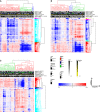miRNA expression changes during the course of neoadjuvant bevacizumab and chemotherapy treatment in breast cancer
- PMID: 31402562
- PMCID: PMC6763780
- DOI: 10.1002/1878-0261.12561
miRNA expression changes during the course of neoadjuvant bevacizumab and chemotherapy treatment in breast cancer
Abstract
One of the hallmarks of cancer is sustained angiogenesis. Favorable results have been reported in some breast cancer (BC) patients receiving antiangiogenic therapy with bevacizumab (Bev) in combination with chemotherapy, and further knowledge on how Bev can be optimally combined with conventional treatment to increase efficacy is strongly needed. In this randomized, neoadjuvant phase II clinical trial, 132 patients with HER2-negative, nonmetastatic BC were treated with Bev in combination with sequential chemotherapy. Biopsies were sampled before treatment, after 12 weeks with anthracycline and after taxane therapy at week 25. MicroRNA (miRNA) expression profiling was performed on biopsies from each time point. Altogether, 241 biopsies were analyzed with the aim of identifying miRNA-based biomarkers of response to therapy. Results from the miRNA analyses were reported for the ER-positive cohort, which were previously demonstrated to benefit from antiangiogenic therapy in this study. For both treatment arms of this cohort, significantly different expression was observed for 217 miRNAs between objective responding and nonresponding patients before treatment initiation. These miRNAs have been linked to regulation of epithelial-mesenchymal transition, metastasis, and tumor growth, among other processes. Bev in combination with chemotherapy resulted in similar miRNA changes to chemotherapy alone. However, the deregulation of miRNA expression occurred earlier in the Bev arm. In both arms, tumor suppressor miRNAs were found upregulated after treatment, while oncogenic miRNAs were downregulated in the Bev arm. Patients responding to Bev showed a strong correlation between deregulated miRNAs and decreased proliferation score during the course of treatment, with downregulation of miR-4465 as the strongest indicator of reduced proliferation. Integrative analyses at miRNA-, gene-, and protein expression further indicated a longitudinal decrease in proliferation. Altogether, the results indicate that proliferation might represent a predictive factor for increased Bev sensitivity, which may aid in the identification of patients who could potentially benefit from Bev.
Keywords: angiogenesis; bevacizumab; breast cancer; miRNA; neoadjuvant.
© 2019 The Authors. Published by FEBS Press and John Wiley & Sons Ltd.
Conflict of interest statement
The study was cosponsored by Roche Norway and Sanofi‐Aventis, contributing to the funding of the clinical study. No other potential conflicts of interest were disclosed among the authors.
Figures





Similar articles
-
Genetic variants in VEGF pathway genes in neoadjuvant breast cancer patients receiving bevacizumab: Results from the randomized phase III GeparQuinto study.Int J Cancer. 2015 Dec 15;137(12):2981-8. doi: 10.1002/ijc.29656. Epub 2015 Jul 6. Int J Cancer. 2015. PMID: 26100253 Clinical Trial.
-
Protein Signature Predicts Response to Neoadjuvant Treatment With Chemotherapy and Bevacizumab in HER2-Negative Breast Cancers.JCO Precis Oncol. 2021 Jan 28;5:PO.20.00086. doi: 10.1200/PO.20.00086. eCollection 2021. JCO Precis Oncol. 2021. PMID: 34036235 Free PMC article. Clinical Trial.
-
MicroRNAs miR-7 and miR-340 predict response to neoadjuvant chemotherapy in breast cancer.Breast Cancer Res Treat. 2017 Apr;162(3):511-521. doi: 10.1007/s10549-017-4132-9. Epub 2017 Feb 8. Breast Cancer Res Treat. 2017. PMID: 28181130 Free PMC article.
-
Bevacizumab in combination with a taxane for the first-line treatment of HER2-negative metastatic breast cancer.Health Technol Assess. 2011 May;15 Suppl 1:1-12. doi: 10.3310/hta15suppl1/01. Health Technol Assess. 2011. PMID: 21609648 Review.
-
[Efficacy of neoadjuvant chemotherapy combined with bevacizumab versus neoadjuvant chemotherapy alone for Her2-negative breast cancer: a meta-analysis of randomized controlled clinical trials].Zhejiang Da Xue Xue Bao Yi Xue Ban. 2016 May 25;45(4):379-386. doi: 10.3785/j.issn.1008-9292.2016.07.08. Zhejiang Da Xue Xue Bao Yi Xue Ban. 2016. PMID: 27868411 Free PMC article. Review. Chinese.
Cited by
-
Network Pharmacology Approaches Used to Identify Therapeutic Molecules for Chronic Venous Disease Based on Potential miRNA Biomarkers.J Xenobiot. 2024 Oct 15;14(4):1519-1540. doi: 10.3390/jox14040083. J Xenobiot. 2024. PMID: 39449424 Free PMC article.
-
Micro-RNAs in breast cancer progression and metastasis: A chromatin and metabolic perspective.Heliyon. 2024 Sep 20;10(19):e38193. doi: 10.1016/j.heliyon.2024.e38193. eCollection 2024 Oct 15. Heliyon. 2024. PMID: 39386816 Free PMC article. Review.
-
ctDNA detected by ddPCR reveals changes in tumour load in metastatic malignant melanoma treated with bevacizumab.Sci Rep. 2019 Nov 25;9(1):17471. doi: 10.1038/s41598-019-53917-5. Sci Rep. 2019. PMID: 31767937 Free PMC article.
-
MicroRNA Expression Profiles and Breast Cancer Chemotherapy.Int J Mol Sci. 2021 Oct 6;22(19):10812. doi: 10.3390/ijms221910812. Int J Mol Sci. 2021. PMID: 34639152 Free PMC article. Review.
-
The Role of Circulating MicroRNAs in the Prediction of Response to Neoadjuvant Chemotherapy in Locally Advanced Breast Cancer in the Indian Population.Cureus. 2024 May 2;16(5):e59553. doi: 10.7759/cureus.59553. eCollection 2024 May. Cureus. 2024. PMID: 38832155 Free PMC article.
References
Publication types
MeSH terms
Substances
LinkOut - more resources
Full Text Sources
Medical
Research Materials
Miscellaneous

